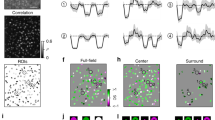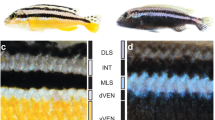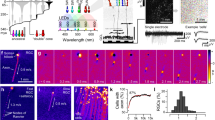Single cones start making a different opsin as young salmon move to deeper waters.
Abstract
Each cone photoreceptor in the retina responds to light in a limited range of wavelengths, giving it a spectral phenotype. This phenotype is determined by the most prevalent of the photoreceptor's visual-pigment proteins (opsins) and is assumed to remain unchanged during an animal's lifetime. Here we show that in the Pacific pink salmon, Oncorhynchus gorbuscha, single cones can switch their spectral phenotype from ultraviolet to blue by regulating the production of the appropriate opsins as the fish grow older. This photoreceptor plasticity may operate to modulate colour vision as the salmon's lifestyle changes.
Similar content being viewed by others
Main
The vertebrate retina has several spectral types of cone photoreceptor. Each photo-receptor contains a visual pigment that is maximally sensitive to ultraviolet (UV), blue, green or red light1and consists of a protein (opsin) attached to a chromophore (a derivative of vitamin A1 or vitamin A2)1. It is the combined input from cones containing different visual pigments, each with a different spectral phenotype, that allows an animal to perceive colour.
Changes in colour sensitivity in the outer retina arise from altering the density of different cone types2 or by switching chromophores (vitamin A2-based visual pigments absorb light of longer wavelengths than their vitamin A1 counterparts)3. Another way to modulate colour vision would be to switch between different opsins, a mechanism that we investigate here in the cone photo-receptors of the Pacific pink salmon.
To determine whether it is possible for such a phenotypic transformation to occur: we measured the absorbance of visual pigment along the outer segment of individual cones by using microspectrophotometry3 (the outer segment of a cone consists of stacked lipid bilayers that contain the visual pigment)1; we also labelled opsin messenger RNAs by using in situ hybridization4 with salmon-specific molecular probes.
We found that all the single cones in recently hatched fish (weight about 0.4 g) contain a visual pigment with maximum absorbance in the ultraviolet (λmax of the visual pigment: 365–375 nm); however, as the fish grew (weight exceeding 0.8 g), the single cones stopped producing UV-opsin and started to produce blue-opsin (λmax of the visual pigment: 425–435 nm) in a transformation event that proceeds from the ventral to the dorsal retina.
When absorbance is measured from the tip to the base of a cone outer segment undergoing such a transformation, the absorbance is ultraviolet-dominated at the tip, becoming blue-dominated at the base (Fig. 1a). As the outer-segment bilayers are produced at the base and removed from the tip5, these results show that the UV-opsin is being replaced by blue-opsin during the transformation.
a, Cones show increased absorbance in the ultraviolet at the tip of the outer segment (right) and increased absorbance of blue light at the base, with intermediate absorbances in between (traces are composite averages from seven cones). b, Tangential retinal section showing single cones labelled by in situ hybridization with probes specific for mRNAs encoding UV-opsin (shown in blue) or blue-opsin (in red); cones coexpressing both mRNAs appear purple (arrows). c,d, Single cones are labelled with only the UV-opsin riboprobe before the switch in opsin expression (c), and with only the blue-opsin riboprobe afterwards (d). Scale bars: b, 5.5 µm; c, 7.8 µm; and d, 13 µm.
In agreement with this finding, fish in the process of transformation have a mixture of ultraviolet- and blue-sensitive cones, with some cones expressing both opsins together (Fig. 1b). Before the transformation, single cones express only UV-opsin (Fig. 1c); afterwards, they express only blue-opsin (Fig. 1d). Salmonid fish also lose some single (corner) cones following this transformation2, further reducing their ultraviolet/blue sensitivity.
This opsin switch in the single cones of pink salmon represents a previously undiscovered way to modulate colour vision. The transformation is linked to a progressive change in the lifestyle of the salmon6, which starts as a planktivore in surface waters, where ultraviolet light is abundant, and becomes a fish-eating predator in deeper waters, where blue-green light prevails. As several other vertebrates are known to co-express different opsins in a cone7,8,9,10, such a mechanism for temporal modulation of colour vision may be widespread.
References
Fein, A. & Szuts, E. Z. Photoreceptors: Their Role in Vision (Cambridge University Press, Cambridge, UK, 1982).
Kunz, Y. W., Wildenburg, G., Goodrich, L. & Callaghan, E. Vision Res. 34, 1375–1383 (1994).
Hárosi, F. I. Vision Res. 34, 1359–1367 (1994).
Forsell, J., Ekström, P. Novales Flamarique, I. & Holmqvist, B. J. Exp. Biol. 204, 2517–2525 (2001).
Besharse, J. C. in The Retina: A Model for Cell Biological Studies Part 1 (eds Aler, R. & Farber, D.) 297–352 (Academic, New York, 1986).
Groot, C. & Margolis, L. Pacific Salmon Life Histories (UBC Press, Vancouver, 1991).
Makino, C. L. & Dodd, R. L. J. Gen. Physiol. 108, 27–34 (1996).
Szél, Á., Van Veen, T. & Röhlich, P. Nature 370 336 (1994).
Lukáts, Á. et al. Invest. Ophthalmol. Vis. Sci. 43, 2468–2473 (2002).
Parry, J. W. L. & Bowmaker, J. K. Invest. Ophthalmol. Vis. Sci. 43, 1662–1665 (2002).
Author information
Authors and Affiliations
Corresponding author
Ethics declarations
Competing interests
The authors declare no competing financial interests.
Rights and permissions
About this article
Cite this article
Cheng, C., Novales Flamarique, I. New mechanism for modulating colour vision. Nature 428, 279 (2004). https://doi.org/10.1038/428279a
Issue Date:
DOI: https://doi.org/10.1038/428279a
This article is cited by
-
Rapid adjustment of cone opsin expression profiles may help Western mosquitofish (Gambusia affinis) maintain foraging efficiency in distinct light environments
Hydrobiologia (2023)
-
Evolutionary ecology of the visual opsin gene sequence and its expression in turbot (Scophthalmus maximus)
BMC Ecology and Evolution (2021)
-
The time-keeping hormone melatonin: a possible key cue for puberty in freshwater eels (Anguilla spp.)
Reviews in Fish Biology and Fisheries (2019)
-
Experimental evaluation of the effect of a light-emitting diode device on Chinook salmon smolt entrainment in a simulated river
Hydrobiologia (2019)
-
Exploring visual plasticity: dietary carotenoids can change color vision in guppies (Poecilia reticulata)
Journal of Comparative Physiology A (2016)
Comments
By submitting a comment you agree to abide by our Terms and Community Guidelines. If you find something abusive or that does not comply with our terms or guidelines please flag it as inappropriate.




